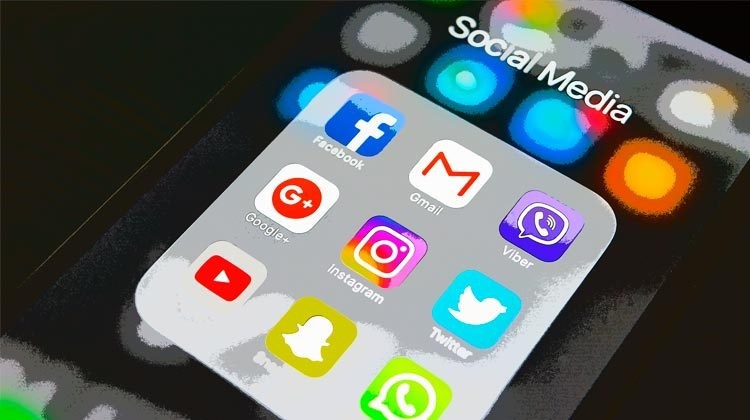Getting Started with Paid Social Advertising: A Beginner’s Guide
by Jacob Baadsgaard • February 26, 2018
These days, it’s pretty hard to ignore paid social media advertising. 3.2 billion people use the internet worldwide. Of these, two-and-a-half billion are social media users, with Facebook alone having over 1.9 billion unique users per month.
With statistics like these, any online marketing strategy needs to include social media.
If you’re a social media user, however, you probably signed up because it was free, making “paid social” feel almost oxymoronic. Why would you want to give a social media platform money? And, even if you do choose to pay to play on social media, which platform(s) should you use?
Why Paid Social Advertising Matters
When it comes to advertising your business online, there are 3 main reasons why you should consider paid social:
1. Increased Reach
The first reason to consider paid social advertising is that—without paying—your business’s social media presence probably isn’t doing much good.
On Facebook, for example, unpaid posts from your site only have the potential to reach those who “like” your page, and even among those only about 1% will ever visit your business’ page, much less proceed to your website or make a purchase.
What’s more, if you’re not paying for social media ads, then you can only get social media exposure through word-of-mouth, which may be extremely limited.
Paid social allows you to share your content with a worldwide audience. These ads not only increase brand awareness, but they can offer viewers a whole range of ways to interact with your company such as browsing and purchasing items, redeeming offers, filling out forms and downloading apps, often without even leaving the social media platform! Your average organic social media post can’t do that!
2. Audience Targeting
Although social media can help you reach a wide audience, that doesn’t mean your ads have to take a shotgun approach.
Social media platforms have a lot of information about their users’ demographics, likes, dislikes, interests, and behaviors—all of which you can leverage to target your desired audience with pinpoint accuracy.
In addition, each different social media platform attracts a different audience in and of itself. That allows you to make your advertising more effective by choosing to focus on the watering hole where your customers like to drink.
I’ll get more into this later when I go over the pros and cons of the industry’s biggest players.
3. Advertising with Benefits
A few paragraphs ago, I said that relying on word-of-mouth to spread your social media presence can be ineffective. That’s true if it’s your only strategy, but once you have some paid social campaigns in gear, word-of-mouth can be a great way to expand the reach of your ads for free.
People usually form connections on social media because they have something in common. That means if you can engage somebody with your paid social content then there’s a chance that they may choose to share it with connections who didn’t see your ad but share a common interest.
This kind of referral can be especially powerful since people tend to trust the recommendation of their friends over other media sources. In fact, it’s been reported that as many as 92% of people value the opinion of a friend more than any type of ad.
Once you get exposure through paid social avenues, the power of word-of-mouth marketing can make your social media efforts even more effective.
Put your Money Where Your Market is
Now that we’ve covered some of the advantages of paid social advertising, let’s review some of the big dogs in the industry to help you identify a good fit for your company.
Facebook Ads
Facebook Ads is the obvious place to start. As the current industry leader, it towers over the competition with over 1.9 billion registered accounts.
Not only does Facebook reach a lot of people, it has also been around longer (and has been offering advertising options longer) than many other platforms.
This experience has allowed Facebook to develop some pretty good advertising options. Paid social on Facebook gives you access to a myriad of audience targeting options as well as ad types designed to match the needs of almost any business you can think of.
Ads on Facebook are run through the Facebook Ads Manager, which offers several analytics options to track the performance of your campaigns.
Facebook users typically fall between ages 18 and 4, and are predominantly female. Three out of four users spend 20 minutes or more on the site per day, giving you plenty of time to reach your targeting audience with your content.
Instagram Ads
Instagram is one of the younger social media networks, but has quickly risen in popularity. Although it was purchased by Facebook in 2012, Instagram continues to attract a slightly different demographic from the Facebook crowd.
Instagram users tend to be quite young (59% are under 30 years old) and are predominantly female. Users spend a lot of time on the app, with recent statistics suggesting that those under 25 years old spend an average of 32 minutes per day on the app, while older users spend 24 minutes/day.
In addition, Instagram is a primarily visual experience.
Users interact with pictures and videos much more than with words. This can be a challenge for some businesses, but if your sell items or services with a strong visual component then Instagram advertising can really pay off.
80% of Instagram users follow brands, 75% of those who view branded posts take some kind of action (visiting the business’ page, etc) and Instagram users are 70% more likely to make mobile purchases than other mobile users!
The visual-centric approach of Instagram limits the types of ads you can display to mostly pictures, videos and product carousels, but the company’s relationship with Facebook gives you access to the whole suite of Facebook Ads Manager tools to formulate and analyze your advertising campaigns.
Pinterest Promoted Pins
While I’m on the subject of picture-driven social media, let’s discuss Pinterest. Paid social on Pinterest is still a work in progress and it offers less options for ad types and campaign management tools than some other networks.
Still, Pinterest has a very unique niche market and offers some advertising advantages that other platforms do not.
For example, rather than being annoyed by them, users seem to almost prefer product pins. Pictures with prices listed on them get 36% more likes than those without.
Pinterest users are much more likely to be female than male, allowing your pins to target this gender group more accurately. Pinterest also engages a wider age range in its audience than some other platforms, with user age pretty evenly distributed between 18 and 64 years old.
Perhaps Pinterest’s greatest claim to fame, however, is the stellar longevity of pins. The half-life of a pin (the amount of time it takes for 50% of pin engagement to occur) is about 3.5 months…which is 1,680 times greater than the 90-minute half-life of the average Facebook post, and 6,300 times longer than a Tweet.
If you have engaging, beautiful product pictures to share, then Pinterest may be for you. Check out this article by Mitt Ray for a data-driven approach to making the most effective pins possible.
YouTube Advertising
Creating picture ads for Instagram and Pinterest takes only a camera and a computer (or maybe just a camera phone), but if you have the resources to produce quality video content then you may have what it takes to break into the enormous YouTube market.
YouTube is huge. Every day the world watches 1 billion hours of YouTube videos. As Cristos Goodrow—YouTube’s VP of engineering—observed, that’s equivalent to 100,000 years…more than all of human history.
While TV engagement has been declining over the past few years, YouTube viewership has skyrocketed, making it the next big thing for video advertising.
If you can create engaging videos (think movie trailers), then people may seek out your content whether or not you pay to have it promoted. For example, in 2014 four of the top ten YouTube videos were advertisements.
Another useful type of video content is instructional videos. The number of YouTube how-to searches increases by 70% every year, so if you can create videos on using your products then consumers are more and more likely to be exposed to them and hopefully to search for them when they are ready to make a purchase.
YouTube is in the minority of social media platforms in that it attracts more men than women, so if you’re looking to promote a particularly masculine brand, it may be a better option than some of the other paid social channels we’ve discussed so far.
Since YouTube is owned by Google, if you want to pay to expand your viewership then your advertising campaigns will be backed by the full power of AdWords and Google Analytics.
There are several types of ads available. Clickable display and overlay ads are good options for those without video making capabilities. You can also pay to have your videos promoted in the suggested list on the right hand side of the page.
The most familiar type of YouTube ads are skip-able and non-skip-able video ads inserted before or during other users’ video content.
These are essentially the same as television ads, except that the skip-able ads (called “TrueView”) function as YouTube’s version of pay-per-click. A viewer is forced to watch the first five seconds of the video, after which they can skip the ad or keep watching it if they’re curious. You only pay if the viewer watches for over 30 seconds.
Those who watch TrueView ads to completion are 23 times more likely to visit or subscribe to a brand channel, share a brand video, or watch more by the brand. Even those who don’t watch to the end are 10 times more likely to do one of those things.
With only around 100 million members LinkedIn certainly does not have the reach of some other social networks, but what it lacks in size it makes up for in a specifically targeted audience.
Those on LinkedIn are less likely than average to use other social media platform, giving you access to some individuals which can’t be found elsewhere on the web. Male and female usership is close to even, and is skewed toward a higher income (>$75,000/year) demographic.
LinkedIn is designed to enable business connections, so it is a natural choice for business-to-business (B2B) marketing.
Linkedin claims that as much as 80% of all B2B leads come from LinkedIn and that it is also responsible for 46% of social media traffic to B2B sites.
True to its purpose, Linkedin has detailed data on its users’ industry, professional history, job titles, qualifications, etc. allowing you to target your ads so the they reach people in the right position in your target businesses.
Ad options include sponsored InMail (which sends messages straight to your target audience’s inboxes), boosted content from your business site and sidebar ads.
Finally, B2B lead generation often involves quite a bit of form-filling. Linkedin streamlines this by prepopulating forms from account information for anyone who clicks on your ads.
Known for its pithy, 280-character or less tweets, Twitter is another popular social media platform for the younger generation, with male and female usage split evenly.
Twitter describes its users as 80% “affluent millennials.” The majority of users fall between 18 and 29 years old, 45% have a college degree, and thirty percent of Americans earning $75,000+ use the platform.
As a mature social media outlet, the advertising options offered by Twitter are pretty similar to Facebook’s. Unlike Facebook, however, Twitter users spend a lot of time searching the site for news and information. This allows Twitter to offer keyword targeting options very similar to those of paid search engine ads.
Since the number one reason use Twitter is to “discover something new and interesting”, information businesses like news sites and blogs can thrive here. Other businesses may do quite well too, provided you can be short and sweet as you share your message!
Snapchat
The last of the big paid social dogs is Snapchat. Now approaching 200 million users, this app is extremely popular among the younger generation. 7/10 snapchat users are millennials and 30% of teens consider Snapchat to be their most important social networking tool.
These users are also quite loyal, clocking in only slightly less time on the app every day than those on Instagram.
Snapchat does offer advertisers several options to get exposure, but Snapchat users seem to take to it less readily than on other platforms.
87% of users say they never buy things they see on Snapchat, the majority do not use branded features such as Discover Stories and Branded Filters, and 64% don’t even follow any celebrities.
Perhaps it is because of the young age of the Snapchat demographic that it is primarily used for interpersonal interactions, but whatever the reason, Snapchat is one of the harder social media platforms to advertise on.
Summary
Social media is such an important presence in the daily life of so many internet users that online marketers can hardly ignore it. Even so, audience quality is often much more important than quantity, so it’s important to clearly identify your target audience before beginning a paid social advertising campaign.
Thankfully, there are social media options to match almost any business’ needs: old, young, male, female, businessperson and avid DIY-er all have a network that calls to them. If you can discover the right network for your customers, you can be where they spend their time.
By the way, if you’d like help identifying the right paid social media channel for your business, let me know here or in the comments. I’d love to help!
Have you tried paid social advertising? What was your experience like? Have any advice for businesses who are just starting with paid social advertising? Leave your thoughts in the comments below!





